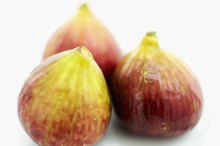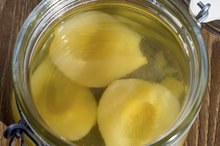What does fact checked mean?
At Healthfully, we strive to deliver objective content that is accurate and up-to-date. Our team periodically reviews articles in order to ensure content quality. The sources cited below consist of evidence from peer-reviewed journals, prominent medical organizations, academic associations, and government data.
- Harvard School of Public Health: Glycemic index and glycemic load for 100+ foods
- Harvard Health Publications: Use Glycemic Index to Help Control Blood Sugar
The information contained on this site is for informational purposes only, and should not be used as a substitute for the advice of a professional health care provider. Please check with the appropriate physician regarding health questions and concerns. Although we strive to deliver accurate and up-to-date information, no guarantee to that effect is made.
The glycemic index is a score that indicates how much a food or beverage raises your blood glucose level 2. This helps people with diabetes plan their meals to keep blood sugar balanced. It also helps anyone who is watching their weight because high blood sugar triggers insulin and insulin promotes fat storage. Even though peaches are a source of sugar, their glycemic index score lets you know they have a small impact on blood sugar 24.
Glycemic Index Explained
As your body digests carbohydrates, they're broken down into simple sugars that enter your bloodstream. Some foods release their sugar into your bloodstream quickly and cause a big spike in blood sugar levels. The glycemic index gives you a way to choose foods based on their impact 2. It measures how much each food boosts blood sugar compared to pure glucose. Foods are assigned a score based on a scale of one to 100, where pure glucose equals 100.
- As your body digests carbohydrates, they're broken down into simple sugars that enter your bloodstream.
- The glycemic index gives you a way to choose foods based on their impact 2.
Glycemic Index of Peaches
Apple Varieties With Less Sugar
Learn More
Peaches fall into the category of low glycemic foods 2. According to the Harvard School of Public Health, a 120 gram serving, which is a small peach, has a glycemic index score of 42 124. A score of 55 or less is a low glycemic index rating, 56 to 69 is a moderate rating and 70 or above means it's a high glycemic food 24. Different factors can make the score fluctuate. If you eat a larger piece of fruit, it's impact may be higher and as fruit ripens, the glycemic index goes up 24.
Comparison to Other Fruits
Peaches have a nearly identical glycemic index rating as oranges and grapes, which have GI scores of 42 and 46, respectively 24. They have a slightly higher GI rating than pears and apples that both score 38 and peaches are slightly lower than bananas at 51. Peaches have a significantly lower GI than watermelon, which scores 72.
Whole Fruit Versus Canned
The Glycemic Index for Tangerines
Learn More
It is notable that the rating of 42 applies solely to the whole fruit, not to canned peaches or peach-flavored beverage. The glycemic rating can change when a fruit is canned or made into "fruit drink" that contains added sweeteners because they dramatically increase the glycemic index rating 2. The Harvard School of Public Health notes that the same 120 gram peach that is canned and preserved in a light syrup receives a GI rating of 52 1.
Sugar Does Not Mean High GI
Fruits and sugary sweets or baked goods all contain simple sugars, yet fruits are low on the glycemic index and sweets are high 2. The reason for the difference is that fruits also contain fiber and fiber moderates the rate at which the natural fruit sugar enters your blood stream. The same concept applies to foods such as white rice, which doesn't contain fiber and has a glycemic score of 89, while fiber-rich brown rice has a score of 50 2.
Related Articles
References
- Harvard School of Public Health: Glycemic index and glycemic load for 100+ foods
- Glycemic Index: The Glycemic Index
- Harvard Health Publications: Use Glycemic Index to Help Control Blood Sugar
- Ojo O, Ojo OO, Adebowale F, Wang XH. The effect of dietary glycaemic index on glycaemia in patients with type 2 diabetes: A systematic review and meta-analysis of randomized controlled trials. Nutrients. 2018;10(3):373. Published 2018 Mar 19. doi:10.3390/nu10030373
- Glycemic Index and Diabetes. American Diabetes Association
- Search for the Glycemic Index. The University of Sydney
- Zeevi D, Korem T, Zmora N, et al. Personalized Nutrition by Prediction of Glycemic Responses. Cell. 2015;163(5):1079-1094. doi:10.1016/j.cell.2015.11.001+
- Sacks FM, Carey VJ, Anderson CA, et al. Effects of high vs low glycemic index of dietary carbohydrate on cardiovascular disease risk factors and insulin sensitivity: the OmniCarb randomized clinical trial. JAMA. 2014;312(23):2531-41. doi:10.1001/jama.2014.16658.
- Vega-lópez S, Venn BJ, Slavin JL. Relevance of the Glycemic Index and Glycemic Load for Body Weight, Diabetes, and Cardiovascular Disease. Nutrients. 2018;10(10). doi:10.3390/nu10101361
- Glycemic Index Database. University of Sydney. Updated October 13, 2020
- Eleazu C. O. (2016). The concept of low glycemic index and glycemic load foods as panacea for type 2 diabetes mellitus; prospects, challenges and solutions. African health sciences, 16(2), 468–479. doi:10.4314/ahs.v16i2.15
- Foster-Powell, Kaye, Holt, Susanna and Brand-Miller, Janette. "International table of glycemic index and glycemic load values: 2002." American Journal of Clinical Nutrition. 76,:1: 5-56 (2002).
- International Carbohydrate Quality Consortium, Jenkins, D. J., Willett, W. C., Astrup, A., Augustin, L. S., Baer-Sinnott, S., … Wolever, T. M. (2014). Glycaemic index: did Health Canada get it wrong? Position from the International Carbohydrate Quality Consortium (ICQC). The British journal of nutrition, 111(2), 380–382. doi:10.1017/S0007114513003905
- Leroux, MarcusFoster-Powell, Kaye, Holt, Susanna and Brand-Miller, Janette. "International Table of Glycemic Index and Glycemic Load Values: 2002." American Journal of Clinical Nutrition. Vol. 76, No. 1, 5-56, (2002).
- Lui, S., Willett, WC, et al. "A prospective study of dietary glycemic load, carbohydrate intake, and risk of coronary heart disease in US women.." American Journal of Clinical Nutrition. 71(6):1455-61. (2001).
- Mayer-Davis, E.J., Dhawan, A et al. "Towards understanding of glycaemic index and glycaemic load in habitual diet: associations with measures of glycaemia in the Insulin Resistance Atherosclerosis Study.." British Nutrition Journal. 95(2):397-405. (2006).
- Sacks, F. M., Carey, V. J., Anderson, C. A., Miller, E. R., 3rd, Copeland, T., Charleston, J., … Appel, L. J. (2014). Effects of high vs low glycemic index of dietary carbohydrate on cardiovascular disease risk factors and insulin sensitivity: the OmniCarb randomized clinical trial. JAMA, 312(23), 2531–2541. doi:10.1001/jama.2014.16658
- Salmeron, J, Manson, JE, et al. "Dietary fiber, glycemic load, and risk of non-insulin-dependent diabetes mellitus in women.." Journal of the American Medical Association. 12;277(6):472-7. (1997).
- Vega-López, S., Venn, B., & Slavin, J. (2018). Relevance of the Glycemic Index and Glycemic Load for Body Weight, Diabetes, and Cardiovascular Disease. Nutrients, 10(10), 1361. doi:10.3390/nu10101361
- Zeevi, D. Korem N. et al. Personalized Nutrition by Prediction of Glycemic ResponsesCell. 163:(5):1079-94. November 2015.
Writer Bio
Jenna Cee has been writing professionally since 2006. Her articles appear on 2Athletes.com and Women's Fitness Online. She is a personal trainer certified by the National Academy of Sports Medicine and as a fitness and sports nutritionist through the International Sports Sciences Association. Cee holds a Master of Science in human nutrition from Washington State University.









